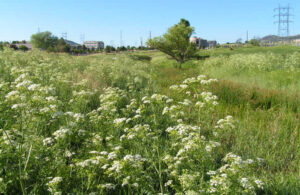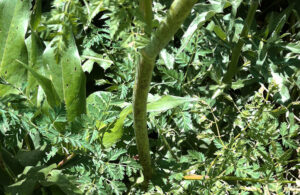Poison Hemlock
Poison Hemlock
Conium Maculatum
Poison hemlock is a List C biennial species and belongs to the parsley family (Apiaceae).
It is an escaped ornamental that is found through the contiguous United States. Poison hemlock invades riparian corridors, irrigation ditches, pastures, and waste places.
Plants grow up to a height of six feet tall and have umbelliferous inflorescences (umbrella shaped) at the end of branches. The individual flowers are white and less than a ¼ inch wide. Leaves are alternate and finely divided, giving it a fern-like appearance. Purple splotches along the stem differentiate poison hemlock from the native water hemlock. Poison hemlock is a lookalike to many edible plants such as wild carrot, oshá, and Indian celery.
Poison hemlock is toxic to humans and livestock (cattle, swine, goats, horses, and sheep). The primary toxin in coniine. Poison hemlock’s claim to fame is it’s use in the execution of Socrates.
RESOURCES
DiTomaso, J, et al. 2013. Weed Control in Natural Areas in the Western United States. UC Weed Research and Information Center.
Noxious Weeds of Colorado 14th Addition
Colorado Weed Management Association
https://cwma.org/weed-information/publications/
PHOTO CREDITS
Jeffco Invasive Species Management




